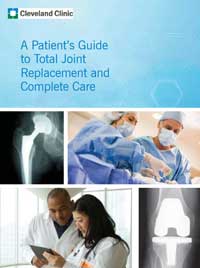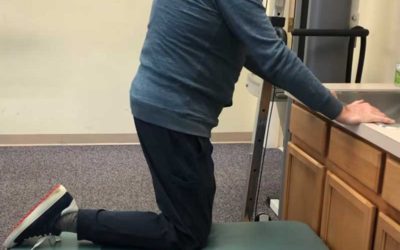Preparing for a Knee Replacement the EASY Way
The best way to prepare for a total knee replacement surgery is to follow these three steps:
Step 1 – Take a pre-operative knee replacement class.
Step 2 – Schedule a pre-operative physical therapy evaluation.
Step 3 – Create a battle plan for your recovery.
Step 1 – Take a pre-operative knee replacement class.
Cleveland Clinic’s A Patient’s Guide To Total Joint Replacement and Complete Care is a great resource with comprehensive checklists from one of the leading joint replacement programs in the country.
A total knee replacement class will teach you everything you need to do before surgery, the day of surgery, and after surgery.
What if my surgeon doesn’t offer a class?
If your surgeon doesn’t offer a class then consider taking my class or find one online or in person.
Much of the material is the same regardless of surgeon or surgical procedure.
Step 2 – Schedule a pre-operative physical therapy evaluation.
Physical therapy is widely recommended after a joint replacement. Clients may also choose to start physical therapy before a joint replacement.
As a physical therapist myself, I can tell you that some of the most important parts of a pre-surgical physical therapy evaluation is the time spent answering questions, taking measurements, practicing with your walker, and preparing you for the best possible outcome.
What can I expect from a pre-surgical physical therapy evaluation?
Since your physical therapist has most likely worked with several hundred patients who have already had a hip or knee replacement you will be able to learn from all of that experience.
Your therapist has seen the good and the bad and will provide you with great advice for your before surgery.
Your therapist will also be able to help you fit your walker, cane, or crutches to your body and teach you how to use these devices with enough time for you to get some practice.
You will develop a pre-surgical strength and conditioning program that will not make your knee pain worse, but will help you improve the muscle health and improve your body’s ability to recover from surgery.
I recommend having a pre-operative physical therapy evaluation approximately 6-weeks prior to surgery. This will allow you enough time to learn everything you need and practice the exercises you have been shown.
Step 3 – Create A Battle Plan
Joint replacement surgery is major surgery. You should hope for the best while planning for the worst.
This means you want to start with a list of all the daily chores and responsibilities you perform in a day. Then decided who will be performing these activities while you are recovering.
In the best case scenario you should plan to be unavailable for 2 weeks, but this could be as long as 12 weeks depending on your body’s response to surgery.
Determine who will buy groceries, who will prepare meals, who will wash laundry, clean the bathrooms, take out the trash, feed the pets.
The less you have to worry about after surgery the better your recovery will go.

More Blog Posts …
Best Shoulder Pulleys for Frozen Shoulder for 2022
This article has been updated on 02/17/2023 by author - Anthony Maritato, PTAre Shoulder Pulley Exercises Good for Frozen Shoulder (Adhesive Capsulitis)? Yes, shoulder pulley exercises are a great way to unfreeze a frozen shoulder. A licensed physical therapist will...
When can I take off my shoulder sling after rotator cuff repair shoulder surgery?
Every surgeon will have a very specific post surgical protocol and instructions telling you exactly what you are allowed to do and not allowed to do after surgery. Most surgeons will require you to wear your shoulder sling after rotator cuff repair shoulder surgery...
2022 Guide to Buying An Elliptical After Total Knee Replacement Surgery
The Schwinn Elliptical 411 is my overall favorite pick for anyone recovering from a total knee replacement in 2022. What to expect in this article: Benefits of using an elliptical after total knee replacement Challenges of using an elliptical after total knee...
When Is Kneeling Safe After A Total Knee Replacement
Unless your surgeon specifically advised against kneeling you are generally safe to start kneeling after 6-weeks or once your surgical incision is healed.Kneeling After A Total Knee Replacement Depending on the implant and bone quality, kneeling after a knee...
Pinching Behind Your Knee After Total Knee Replacement
A common report I get from clients who are struggling to improve knee flexion is that they are feeling a pinch in the back of their knee as they try to bend it. This pinching in the back of your could may be caused by the implant pinching the soft tissue or a baker's...
What to Expect the First Week After your Knee Replacement Surgery
Week 1 After Knee Replacement Surgery If your surgery was performed in an outpatient surgery center then you would have likely been discharged to your home the day of surgery. In this article I will be discussing what you need during the first week after total knee...
How to Choose the Best Physical Therapist
There are many factors that go into choosing the best physical therapist for your rehabilitation. One such factor is access. If you are having a total knee replacement you will inevitably have questions about your incision or positioning or any number of other...
9 BEST Gift Ideas for Anyone Having A Total Knee Replacement in 2022
This article includes my favorite list of the 9 Best Gift Ideas for Anyone Having a Total Knee Replacement in 2022. Cyotherapy Moist heat Walker tray/basket Ankle & Calf Massager Rolling Pin Water Bottle Journal Audio Book Membership Meal Delivery Cryotherapy...
Tight Calf Muscle After Knee Replacement
Calf pain after a total knee replacement or other knee surgery if very common. Part of the problem is the swelling, part is weakness in the muscle and part is the dramatic change in activity level.
In this video I explain these three causes of calf pain as well as some solutions we usually recommend in the clinic. After watching this video I will share recommended exercises you can ask your therapist about.
Baker’s Cyst After Knee Replacement
A Baker's cyst resolved in only a small number of patients (15%) one year after TKA and symptoms from the cysts persisted in 31%. Cite this article: Bone Joint J 2016;98-B:1185-8.[1]What is a Baker's Cyst?If you have ever felt that painful swollen lump behind your...




